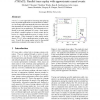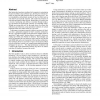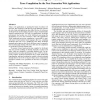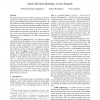1816 search results - page 22 / 364 » Trace oblivious computation |
FAST
2007
13 years 11 months ago
2007
//TRACE1 is a new approach for extracting and replaying traces of parallel applications to recreate their I/O behavior. Its tracing engine automatically discovers inter-node data ...
EGH
2009
Springer
13 years 7 months ago
2009
Springer
Ray tracing has long been considered to be superior to rasterization because its ability to trace arbitrary rays, allowing it to simulate virtually any physical light transport ef...
VEE
2009
ACM
14 years 4 months ago
2009
ACM
Today’s web applications are pushing the limits of modern web browsers. The emergence of the browser as the platform of choice for rich client-side applications has shifted the ...
SPAA
2006
ACM
14 years 3 months ago
2006
ACM
We initiate the study of semi-oblivious routing, a relaxation of oblivious routing which is first introduced by R¨acke and led to many subsequent improvements and applications. ...
ISCAPDCS
2003
13 years 11 months ago
2003
Branch predictors and processor front-ends have been the focus of a number of computer architecture studies. Typically they are evaluated separately from other components using tr...




